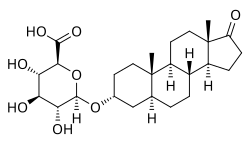
| |
| Names | |
|---|---|
| IUPAC name 17-Oxo-5α-androstan-3α-yl β-D-glucopyranosiduronic acid | |
| Systematic IUPAC name (2S,3S,4S,5R,6R)-6-{pheananthren-7-yl]oxy}-3,4,5-trihydroxyoxane-2-carboxylic acid | |
| Other names ADT-G; 5α-Androstan-3α-ol-17-one 3-glucuronide | |
| Identifiers | |
| CAS Number | |
| 3D model (JSmol) | |
| ChEBI | |
| ChemSpider | |
| KEGG | |
| PubChem CID | |
| UNII | |
| CompTox Dashboard (EPA) | |
InChI
| |
SMILES
| |
| Properties | |
| Chemical formula | C25H38O8 |
| Molar mass | 466.571 g/mol |
| Except where otherwise noted, data are given for materials in their standard state (at 25 °C , 100 kPa). Infobox references | |
Androsterone glucuronide (ADT-G) is a major circulating and urinary metabolite of testosterone and dihydrotestosterone (DHT). It accounts for 93% of total androgen glucuronides in women. ADT-G is formed from androsterone by UDP-glucuronosyltransferases, with the major enzymes being UGT2B15 and UGT2B17. It is a marker of acne in women while androstanediol glucuronide is a marker of hirsutism (excess hair growth) in women.
Relevance in women's health
Quantification of ADT-G and 3α-diol-G levels in Serum (blood) is an effective means of assessing androgen content in blood and androgenic activity in women. Androsterone glucuronide content can be estimated using Liquid chromatography–mass spectrometry. If an unusual level of ADT-G is observed in the blood (either an elevated or decreased amount), proper treatment plans can be developed in order to treat related symptoms.
Elevated levels of androsterone glucuronide in the blood have been observed in adult females who present with inflammatory acne. The introduction of therapeutic antiandrogen treatment and the use of an oral Contraceptive by women who are affected with androsterone related acne can decrease the amount of inflammatory acne present.
See also
References
- ^ "Human Metabolome Database: Showing metabocard for Androsterone glucuronide (HMDB0002829)".
- Jerome F. Strauss, III; Robert L. Barbieri (13 September 2013). Yen and Jaffe's Reproductive Endocrinology. Elsevier Health Sciences. pp. 837–. ISBN 978-1-4557-2758-2.
- ^ Labrie, Fernand; Bélanger, Alain; Bélanger, Patrick; Bérubé, René; Martel, Céline; Cusan, Leonello; Gomez, José; Candas, Bernard; Castiel, Isabelle; Chaussade, Véronique; Deloche, Claire; Leclaire, Jacques (2006-06-01). "Androgen glucuronides, instead of testosterone, as the new markers of androgenic activity in women". The Journal of Steroid Biochemistry and Molecular Biology. 99 (4): 182–188. doi:10.1016/j.jsbmb.2006.02.004. ISSN 0960-0760.
- Ke, Yuyong; Gonthier, Renaud; Isabelle, Maxim; Bertin, Jonathan; Simard, Jean-Nicolas; Dury, Alain Y.; Labrie, Fernand (2015-05-01). "A rapid and sensitive UPLC–MS/MS method for the simultaneous quantification of serum androsterone glucuronide, etiocholanolone glucuronide, and androstan-3α, 17β diol 17-glucuronide in postmenopausal women". The Journal of Steroid Biochemistry and Molecular Biology. 149: 146–152. doi:10.1016/j.jsbmb.2015.02.009. ISSN 0960-0760.
- ^ Carmina, E.; Godwin, A. J.; Stanczyk, F. Z.; Lippman, J. S.; Lobo, R. A. (2002-10-01). "The association of serum androsterone glucuronide with inflammatory lesions in women with adult acne1". Journal of Endocrinological Investigation. 25 (9): 765–768. doi:10.1007/BF03345509. ISSN 1720-8386.
External links